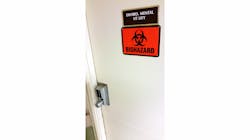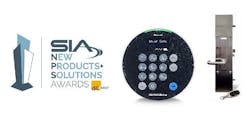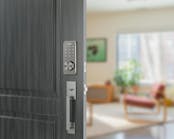Managing keys can be a problem for many people. End-users misplace or lose their keys, or leave them home. Facility management never actually gets around to setting up a key management system.
On many doors, non-controlled keyways are employed, further weakening the security management process since keys may be copied by anyone at any time.
In many healthcare institutional environments, locks are on doors to control access by unauthorized individuals to storage areas, rather than for life safety related use or to inhibit egress.
Of course there are many situations within institutions where egress must also be prevented or controlled. However, controlling or preventing egress is in direct conflict with the Golden Always Free Egress Rule.
Under all of the published fire-code requirements, inhibiting free egress is not permitted. One example is the National Fire Protection Association’s (NFPA) Life Safety Code 101 which says that in general every person within the building must be able to exit all doors in their path to the outside without “the use of a key, a tool, or special knowledge or effort for operation from the egress side” (NFPA 101, 7.2.1.5.2).
For doors with electrically operated locks where there is no integral mechanical means by which the door may be manually unlocked to achieve egress, the requirements are more involved.
In most situations the electronics are there to enable control of access. When the locking device is an electric strike or electrified exit device or lever, there is no problem since these items are typically designed for free egress.
When an electromagnetic lock is used, there is no integral mechanical way to release it, so provision must be made so that egress can be made under all conditions. This requires electrical switches, sensors and control devices be installed on the egress side of the opening to readily unlock the door and enable free egress.
Depending on the building occupancy, the building code in force in the jurisdiction where the structure is located, and perhaps most importantly, the opinion of the Local Authority Having Jurisdiction (LAHJ) will determine the exact requirements for the project.
Most of the criteria addressing permissible access-control measures stipulate that door locks (from the egress side) have to be released upon events such as activation of the building fire-alarm or fire-sprinkler systems. Usually, the lock must remain open until the fire protection system is reset.
Readers can easily research this topic online or contact The Locksmith Ledger for links to the plethora of information available which discusses special locking arrangements and life safety code complaint locking solutions.
By placing access control on openings, the need to distribute and replace keys is eliminated. There are many choices for the locksmith when specifying door controls.
- Standalone mechanical keypads
- Standalone electronic keypads
- Electronic door control systems with discrete locking and input devices. The input device is a keypad, keyswitch, card reader or these days perhaps NFC or Bluetooth.
Keys for such openings are held in reserve and are only used to gain access in an emergency.
Whether a keypad alone is acceptable for security is an important consideration. Whether it is a single code for all or system that supports individual PINs, the argument against a keypad is that a code can be shared or guessed; it is by itself not authenticated, and perhaps less secure than key control.
But a keypad may be what the customer wants, to be relieved of the hassles of key management and providing the convenience of a keypad to the end-users, while still inhibiting casual and undesired ingress into an area.
Code Requirements
One of the intentional consequences of electrically controlling an opening for access is to inhibit egress. This may be achieved with a keypad.
Institutional Occupancies offer unique challenges and are subject to special requirements.
Note: The following code excerpts are to be used as examples only. This may not be the code enforced in your jurisdiction.
International Building Code 2012: SECTION 308 INSTITUTIONAL GROUP I: Institutional Group I occupancy includes, among others, the use of a building or structure, or a portion thereof, in which people are cared for or live in a supervised environment, having physical limitations because of health or age are harbored for medical treatment or other care or treatment, or in which people are detained for penal or correctional purposes or in which the liberty of the occupants is restricted. Institutional occupancies shall be classified as Group I-1, I-2, I-3 or I-4.
308.2 Group I-1: This occupancy shall include buildings, structures or parts thereof housing more than 16 persons, on a 24-hour basis, who because of age, mental disability or other reasons, live in a supervised residential environment that provides personal care services. The occupants are capable of responding to an emergency situation without physical assistance from staff. This group shall include, but not be limited to, the following:
- Alcohol and drug centers
- Assisted living facilities
- Congregate care facilities
- Convalescent facilities
- Group homes
- Halfway houses
Residential board and care facilities
Social rehabilitation facilities
A facility such as the above with five or fewer persons shall be classified as a Group R-3 or shall comply with the International Residential Code in accordance with Section 101.2. A facility such as above, housing at least six and not more than 16 persons, shall be classified as Group R-4
308.3 Group I-2: This occupancy shall include buildings and structures used for medical, surgical, psychiatric, nursing or custodial care for persons who are not capable of self-preservation. This group shall include, but not be limited to, the following:
- Child care facilities
- Detoxification facilities
- Hospitals
While Residential and Institutional occupancies have some things in common, in many important respects they are very different.
For one thing they are subject to scrutiny by a posse of LAHJs from various agencies. Residences are not under a microscope, and sometimes situations exist under the radar.
There are situations where structures are being adapted for different purposes and then fall into non-compliance. Some examples include conversion of residences into pre-K, nursery or hospice facilities.
When the locksmith is called to perform service or installation in such situations, he or she may find multiple violations. Using the rationale that you are merely replacing what was already there and having tunnel vision with respect to other infractions is illegal and you are morally and probably legally liable if anyone is injured and ‘they’ can prove you billed them for services.
If you suspect there is a problem, request to see the Certificate of Occupancy.
Mechanical Pushbutton Solution: Simplex 1000
With 40 years in the marketplace, Simplex mechanical pushbutton locks continue to be the durable, reliable choice for many facility managers. The locks are dependable, easy to maintain, and flexible to meet the needs of today’s fast-paced environment.
Kaba’s Simplex® mechanical pushbutton locks eliminate those headaches of issuing, replacing and controlling keys by using a PIN instead of keys for access by all authorized users. One code — that’s all you have to remember or keep up with — nothing tangible like a key or magnetic card, no batteries to replace in the lock, and no software or computers to control the lock’s operation.
PIN codes are made up of any combination of one to five numbers (pressed individually or simultaneously). The locks allow over 1,000 possible PIN code combinations. PIN codes are quickly and easily changed without removing the lock from the door. This ability to reprogram the buttons eliminates the expense associated with rekeys or replacement of credentials.
For many facility managers mechanical pushbutton locks are a great solution for controlling access between public and private areas. They can be used in conjunction with other security management tools, (for example deadbolts or video surveillance), or as stand-alone security alternative.
Simplex® mechanical pushbutton locks work with cylindrical, mortise, and exit device installations. Locks install easily on metal or wood doors with no wiring or computer programming required.
Other features include:
• Easy to maintain — no batteries to replace.
• Durable heavy-duty construction for outdoor applications and attractive finishes for indoor settings
• Removable or interchangeable cores.
• Optional key override gives emergency personnel quick access to your facility.
• Optional lockout prohibits anyone from entering the facility, even with a PIN code.
• Electric release models give access control to a receptionist via switch button.
• Optional passage feature allows entry without using a PIN code.
For more information, contact your local locksmith distributor or Kaba, Telephone: 800-849-8324. Web: www.kaba-adsamericas.com
Essex Electronic Keypad
When the application suggests that an electronic keypad is required, the Essex Narrow Keypad SKE-26 and Essex Single Gang SKE-34 keypads are excellent choices.
The narrow style is ideal for aluminum door frames, and is illuminated which works well for outdoor night time operation. The single gang unit is easy to use with standard electrical boxes. Both are extremely rugged, and have functionalities which far exceed simply energizing a door lock.
While the keypads can be connected directly to many locking devices, the use of interface (slave) relays with all door controls is highly recommended to assure long term operation and to protect the electronic control from failures due to damage to the SKE internal relay or open collector output.
The SKE has an integral REX input. There are many situations where using the REX is helpful. Among the possible applications of the SKE is to implement a propped/forced door alarm. In this situation using the SKE REX is required to maintain the same door unlock timing.
Another application is with delayed egress. For many delayed egress applications, it is required that the door be normally transgressed from either direction without initiating an alarm. Essex keypads work well in these applications.
Essex SKE keypads can hold hundreds of codes, and can trigger up to three independent outputs. There are ESSEX keypads with Wiegand outputs so they may be used in conjunction with or to replace cardreaders and biometrics.
The SKE-34 is a heavy duty self contained access control keypad with many features that make it suitable for residential, institutional and harsh environments.
The unit has an integral Form “C” 2A main output relay, as well as two open collector outputs which can operate exterior relays and be controlled in a variety of ways. It may be configured to operate at 5 VDC or 12/24VDC.
The keyboard is laser etched Stainless steel piezio actuated with no moving parts, and weather/vandal resistant.
The keypad is available in a 3X4 single gang or 2X6 narrow mullion configuration.
Features include:
- Self-Contained Access Control
- 3 Progammable Outputs
- Up To 500 User Codes (Plus Master And Temproary Code)
- Easy To Install And Operate
- Laser Marked Keypad Graphics
- Weatherproof & Waterproof, -40c To +70c, 100% Relative Humidity
- Available In Several Architectural Finishes
- Draws Only 35Ma at idle
- 1 Billion cycle switch life
- REX input
- Anti-Tailgate feature
- Door forced/AJAR alarm
- Programmed at keypad, no computer or programmer required
- Limited lifetime warranty
For more information, contact your local locksmith distributor or Essex Electronics, Telephone: 800-535-5377. Web: www.keyless.com.
Video Surveillance Helps Protect Seniors
For years, McCrite Plaza Retirement Community, located in Topeka, Kansas, has been considered a premier senior living community. McCrite's goal is to not only offer a safe and active environment for the senior population to reside, but to provide esthetically beautiful surroundings.
The McCrite family recently opened a 163-unit combined senior-living and assisted-living community in Kansas City, MO. To protect resident safety and its investment in the new 200,000-square-foot building, McCrite deployed an enterprise-class Toshiba IP video surveillance system based on very latest in networking technology.
During construction, management of the new McCrite at Briarcliff facility sought out a stable, robust IP-based video surveillance solution providing forensic-quality streaming video images and low-bandwidth consumption. Its mission was to protect residents, monitor staff, deter theft and vandalism, and to further facilitate peace-of-mind for family members.
"McCrite is dedicated to providing only the absolute best for its residents," explained Cassidy McCrite, director of McCrite at Braircliff. "This commitment extends itself to the security equipment we install."
Eve Zimmerman of ITalk Telecontracting, Inc. managed the installation: "McCrite made it clear the entire building and its grounds were to be monitored. We installed Toshiba HD IP cameras in all public spaces, doorways, corridors, exterior parameter, and parking lots, as well as in the health and wellness center and learning center. In all, 64 Toshiba IP cameras have been placed on the network so far."
Because McCrite at Braircliff was new construction iTalk was able to run all new Ethernet cabling throughout the facility along with a fiber backbone. Cables travel back to a network closet housing a Toshiba NVSPRO network video recorder. Video streams are managed through the Toshiba VMS on the NVSPRO, eliminating the need for separate DVRs and minimizing equipment clutter in the closet. With highly-efficient H.264 video compression, the cameras let the McCrite security team archive video for as long as 30 days on the NVSPRO's 8TB hard drive.
The video surveillance system that was adopted indoors makes use of Toshiba IK-WD04A IP mini-dome cameras with 720p HD resolution for on-site security and guest safety. Featuring an extra wide dynamic range and multiple H.264 streaming capabilities, it delivers excellent imaging quality and operator flexibility.
To protect patient privacy, the cameras maintain a narrow field of view while keeping with HIPAA regulations and McCrite's own privacy and confidentiality policies. The IK-WD04A cameras perform well in daylight as well as under low-light conditions, providing McCrite security staff with an edge they never had before.
Outdoor perimeter protection was one of McCrite's fundamental requirements, considering the need to control access of at-risk residents to outside grounds. Video allows security to respond immediately to an emergency situation. Consequently, the overall safety of all guests at McCrite at Briarcliff is enhanced. The task of outside surveillance is performed by Toshiba IK-WR14A vandal-resistant dome cameras with 1080p HD resolution, H.264 compression and SRLED technology for edge-to-edge lighting down to 0 lux.
"We conducted an in-depth study of many cameras from a variety of top brands using a price-to-performance ratio," said Zimmerman. "Toshiba came out number one, and its team delivered a high level of professionalism in the pre- and post-sales support."
The more McCrite security familiarizes itself with the potential of the Toshiba IP surveillance system, the more opportunities they've found to use the technology. In addition to monitoring resident safety, management now has the capability to assure superior service and the productivity of its staff.
For more information, visit www.toshibasecurity.com.
Tim O'Leary
Tim O'Leary is a security consultant, trainer and technician who has also been writing articles on all areas of locksmithing & physical security for many years.






